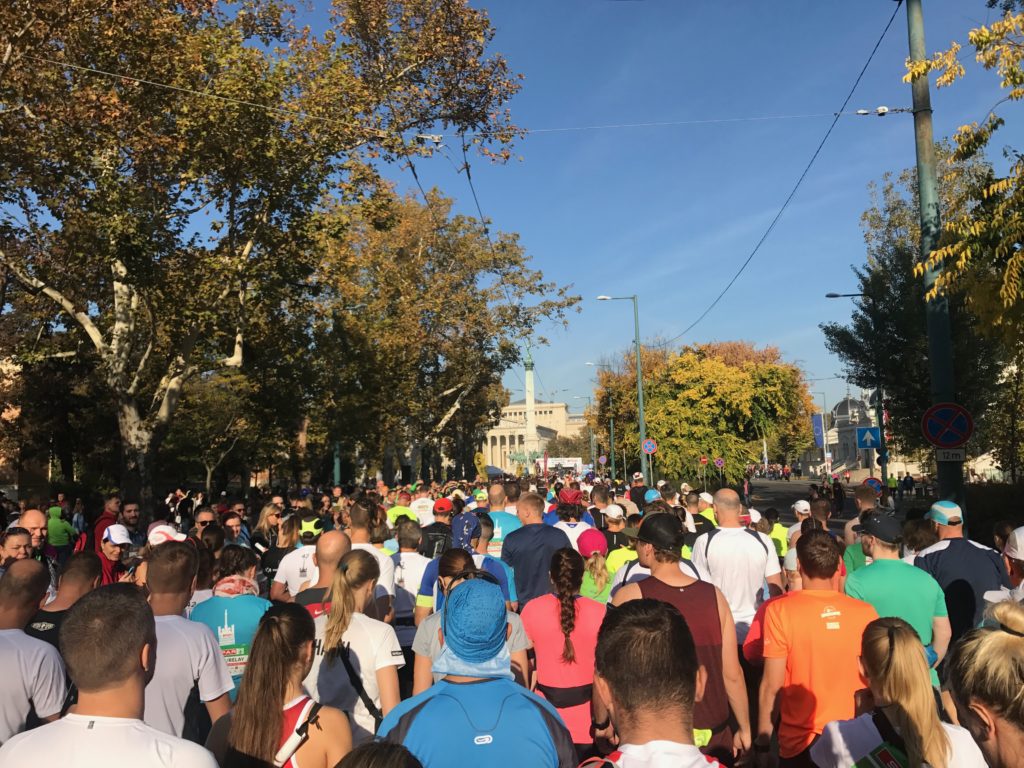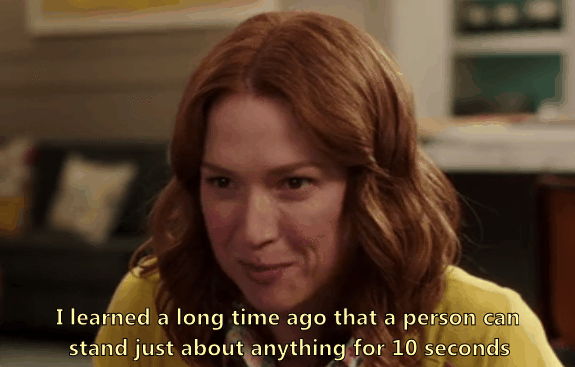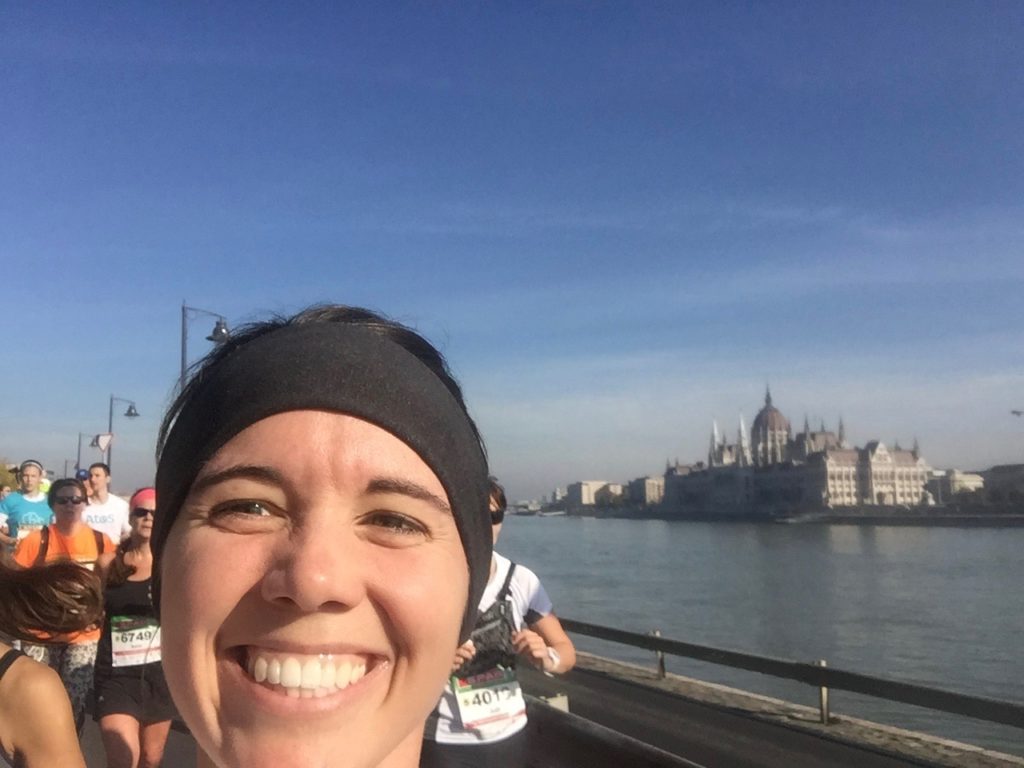Runners, Take Your Marks
The race did start until 9:30 AM, which was much later than we’re used to. This was nice in that we could technically sleep in, but I woke up in a panic at 6:30 thinking that I’d slept through the race. No sleeping in for me.
We walked to the starting area in City Park, only about a 25 minute walk from our hostel, Penthouse Privates. It was the same location as packet pickup, so we were familiar with the area. It was a really relaxing morning actually, because the corrals didn’t even open until 9 AM. We arrived shortly before that and were one of the first in the corral.
With only 6,000 runners, the starting corrals were small and you could see the starting line even from the back of the pack. The start itself was a rolling start which meant that we (in corral 4 out of 5) crossed the starting line only about two minutes after the first corral.

The view of the starting line from Corral 4, right before race start.
Running the Marathon
Running a marathon is a series of tiny goals and tiny accomplishments. I just have to make it to 16K and I get a gummy bear. I just have to make it 5 more K with this pace group and then I can slow up a bit. Only 1 more K till the next aid station.
Sometimes the goals are in kilometers, but sometimes they’re as tiny as crossing a street or making it over a bridge or just getting one foot in front of the other, just one more time. I’m constantly bartering with myself; convincing myself that I can do this tiny task and it’s all I need to worry about. Like Kimmy Schmidt says, you can do anything for 10 seconds.

As the end of the race gets closer, and the kilometers feel even longer, I start to compare them to things I know I can do. 5K is just running home from Belmont Harbor on the Lakefront Trail. I can do that. One mile is just running around EPCOT’s World Showcase Lagoon. I can do that. If Mulan can defeat the Huns and save China, I can do this one thing! (I use the Mulan one a lot actually. “I’ll Make a Man Out of You” is my ultimate power song.)
And eventually, all of these small goals, these small accomplishments, they add up. Eventually I pass the 20 mile marker. Eventually I start to hear the announcer at the finish line. Eventually, the next small goal is crossing the finish line.
And just like that, something that felt so impossible, so far away (literally) a few hours ago, is in your rearview.
The Course
The course was not my favorite. I can’t blame them; I think it’s the best course they could have picked, but it’s not the most fun course I’ve ever run. The course keeps you on the most beautiful area of the city: along the Danube, crossing iconic bridges, and running through their island park. Sounds great, right?

Just a mid-run selfie along the Danube with Parliament in the back.
The course is beautiful, with stunning views of the Buda Castle and Parliament, but that’s pretty much all you get for 26.2 miles. At one point, we ran almost a full 7K (just over 4 miles) straight up along the river, right into the sun. Running point-to-point isn’t so bad if you’re running through neighborhoods maybe, but when you’re just running along the river for so long, you kinda get sick of the view no matter how great it is.
The aid stations were also pretty spread out. There were 12 aid stations along the course, and three of them were just water, compared to say, the Indianapolis Marathon (of comparable participant size) which has 20 aid stations with water and Gatorade. The Chicago Marathon also has 20 aid stations, and while I don’t typically stop at all of them, I always felt like if I needed something, it was within reach. More than once on the course in Budapest did I felt like I needed something and wasn’t able to get it for longer than I’d have liked.
Speaking of the Chicago Marathon …
We’re both blessed and cursed that our hometown marathon is the Chicago Marathon. A marathon major, on a flat course lined with epic spectators, in our backyard (well, our former and probably future backyard). This sets a high bar for any other marathon.
To compare the Budapest Marathon, with its 6,000 runners, to Chicago’s 45,000 runners, wouldn’t really be a useful comparison. The races are just too different and you run them for completely different reasons.
What you can compare though is US marathons to European marathons, and that’s a fun one. We’re not pro’s at foreign marathons, but this was our second (having run Berlin in 2016) and we have started to notice a few things that are different internationally.
Budapest vs US Marathons
- Plastic Cups at Aid Stations: Europeans are generally so eco-obsessed that it blows my mind that they don’t use biodegradable paper cups at aid stations. Not only are the plastic cups not eco-friendly, they’re also a pain in the butt. When you run over a paper cup, it flattens so no one trips on it, it’s less likely to blow away, and it’s not slippery like a broken, wet plastic cup.
- Trash Can Policy: Typically runners throw their cups on the ground, and I get that it’s not great, especially if your course is so close to the river (and you’re using plastic cups that will kill the animals). But if you’re going to ask runners to throw cups away, you have to provide ample trash cans alone the aid station and for a decent distance past them. There was only a couple trashcans right at the end of the aid station and we were frequently left carrying cups for several K looking for trashcans along the course. Also, obviously, most runners still just threw their cups on the ground anyway because it wasn’t practical (and sometimes just unsafe due to the number of people) to use the trash cans.
- Mineral Drinks: Two aid stations were stocked with Calcium and Magnesium drinks, which I’ve never seen on a race course before. I somehow managed to miss these entirely, but Kenny tried the Magnesium and said it helped.
- Sparking Water: At the end of every race, they give you a bottle of water. I opened mine and took a big chug only to discover it was sparkling and cherry flavored. I wasn’t mad about it, but it definitely caught me off guard.
- Glucose Tabs: Many courses in the US have either energy gels or glucose chews like Shot Blocks or Gatorade chews. The Budapest equivalent were these square sugar tabs that tasted a lot like sweet tarts. I really enjoyed these and had a few at every opportunity.
- Lemons: I’ve seen oranges on courses a lot, but never lemons! Again, I didn’t have any, but Kenny did and seemed to enjoy them.
- Energy Drink Flavors: I know that every race doesn’t always have the same flavor of energy drink, but typically there is one flavor served through the whole course. Budapest had a different flavor at every aid station. I didn’t love this, but I guess I didn’t hate it either.
- Semi-looped Course: I know this isn’t unique to international marathons, as I’m sure many US marathon courses are looped, but this was our first looped course. It wasn’t two full loops, but you did run a few segments a second time.
And that’s a wrap.
The race was incredibly well organized from registration to results, there was 26.2 uninterrupted miles to run on and amazing volunteers keeping our bodies fueled. At the end of the day, that’s all you really need out of a marathon. The downside to this race, which was out of the organizers control, was that it seriously lacked spectators and it was a hot day. Because of that, the Budapest Marathon wasn’t my favorite marathon, but I still enjoyed it and I’m happy I ran it.

Finishers!
